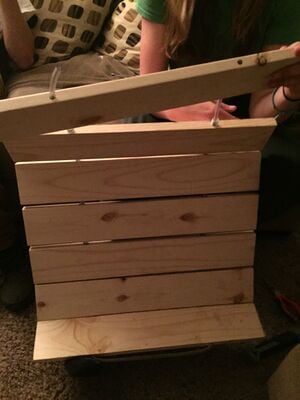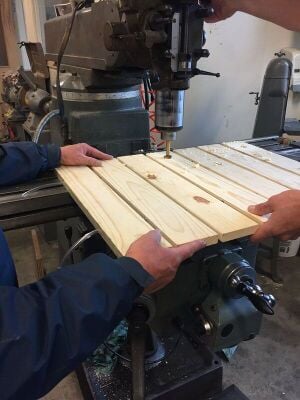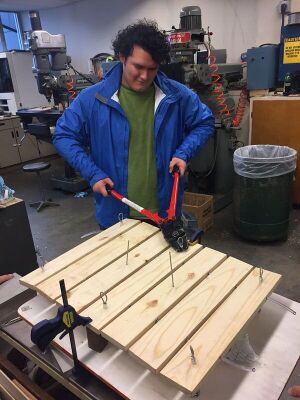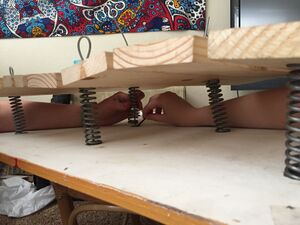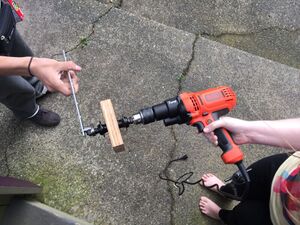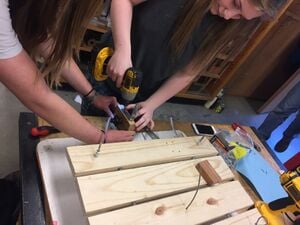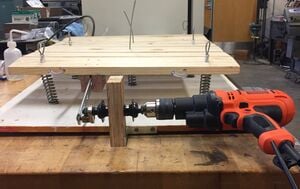
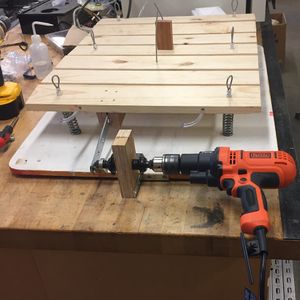
A Shake Table was designed and constructed to imitate earthquake magnitudes to help students at Zane Middle School to better understand seismic activity and allow them to test their own building structures.
Background[edit | edit source]
Zane Middle School is a STEAM (Science, Technology, Engineering, Arts, and Math) school that believes hands on learning is very important for student success. For several years Engineering 215 students at Cal Poly Humboldt have teamed up with Zane's faculty to help them achieve this goal. In Spring 2017, our team was challenged with the construction of a Shake Table that demonstrates shaking of an earthquake. Our Shake Table design specifically allows 7th grade students to learn about the seismic activity in Earth's crust during an earthquake while also providing a way for them to be creative and test their own building designs.
Problem statement (Objective) and criteria[edit | edit source]
The objective of our design was to make the most realistic shake table design possible, and satisfy the needs of our client, Zane Middle School. Our client expressed their desire to illustrate the effects of liquefaction of earth during an earthquake and how the earth undergoes a wave motion at these times. Most standard shake tables don't express this motion so this was one of our challenges. Aside from that, our primary concern was to ensure the device was safe as children would be interacting with it in close proximity.
Below is a table of our criteria and weighted values of importance that our team and client agreed upon:
| Criteria | Constraint | Weight |
|---|---|---|
| Safety | Safe to be used by teacher as well as the students. Also safe for any bystanders. | 10 |
| Sturdiness | Table stays stable during use and shaking. | 9 |
| Cost | Less than or equal to $300 ($100 from Zane Middle School, $50 from each group member) | 9 |
| Shake Levels | At least 3 different shake levels. | 8 |
| Portability | Able to move or be store (portable or foldable). Can be brought to other classrooms easily. | 8 |
| Ease of Use | Able to be used by students as well as the teacher without confusion or damage. | 8 |
| Educational Value | Able to teach the students about the effects of earthquakes just by using it. | 7 |
| Durability | Sustain use for many years. | 7 |
| Consistency | Same shake every time it it used. | 6 |
| Aesthetics | Aesthetically pleasing. | 5 |
Description of final project[edit | edit source]
This design meets the criteria and uses the Flex Board design combined with the Drill Sergeant's power mechanism to achieve an efficient shake level that safely tests structures built by the students at Zane Middle School. Most of the materials were obtained from local stores or donated in order to reduce costs.
This shake table uses a drill to turn an axle, which translates movement along a metal shaft in order to shake the table top. The top of the table is composed of seven wooden slats, each 21 inches long, three inches wide, that are held together using plastic tubing and epoxy with small compression springs in between each slat. The structures that are built by the students will be held to the top of the shake table using straps that are connected to a few of the slats. The top of the table is supported by a total of eight compression springs that are connected to five of the seven wooden slats, three of the slats will have two springs connected to them, but two of the slats will only have one spring. The compression springs that support the tabletop are held in place by a combination of epoxy, setting the end of the spring into the board one-quarter inch, and also compressing the springs one-quarter inch using a wire clamped with aluminum ferrules.
The shake table is mounted on a metal cart that is almost four feet tall, two feet long, and three feet wide. The cart rolls on two regular and two locking casters to prevent movement during testing, but also provides an outlet to power the corded drill that shakes the table top. The cart is big enough to allow the students to watch the structures be tested and has shelves beneath the shake table to allow for more storage space.
Costs[edit | edit source]
Costs included in this project are shown below. Many of the materials were purchased while some were donated.
| Quantity | Material | Source | Cost ($) | Total ($) |
|---|---|---|---|---|
| 2 | 1"x4"x8" Wood Boards | Ace Hardware | 8.99 | 17.98 |
| 8ft. | Vinyl Tubing | Ace Hardware | .23 | 1.84 |
| 1 | Red Spray paint | Ace Hardware | 4.99 | 4.99 |
| 6 | Compression Springs | Ace Hardware, Arcata | 3.29 | 19.74 |
| 2 | Compression Springs | Ace Hardware, Sunny Brae | 3.49 | 6.98 |
| 1 | Steel Bar | The Mill Yard | 3.49 | 3.49 |
| 12 | Aluminum Ferrules | Ace Hardware, Arcata | .80 | 9.60 |
| 2 | Aluminum Ferrules | Ace Hardware, Sunny Brae | .99 | 1.98 |
| 12 | Mini Springs | Ace Hardware, Eureka | .75 | 9.00 |
| 1 | Epoxy | Ace Hardware, Eureka | 4.99 | 4.99 |
| 1 | Axle Hub | Arcata Scrap and Salvage | 5.00 | 5.00 |
| 1 | Drill | Pierson Building Center | 50.00 | 50.00 |
| 1 | Base Board | The Mill Yard | Donated | 0.00 |
| 6ft | Braided Wire Cable | Marty's Shop | Donated | 0.00 |
| 1 | Cart | Zane Middle School | Donated | 0.00 |
| Collin and Marty's Help: Drilling, Sawing | Marty's Shop | Priceless | 0.00 | |
| 12 | Wood Screws | Marty's Shop | Donated | 0.00 |
| 1 | Bolt | Marty's Shop | Donated | 0.00 |
| 4 | Spokes | Arcata Scrap and Salvage | Donated | 0.00 |
| 2 | Metal Corner Braces | Marty's Shop | Donated | 0.00 |
| 2 | Aluminum Ferrules | Marty's Shop | Donated | 0.00 |
| Total Cost | $135.59 | |||
Testing Results[edit | edit source]
When testing the shake table for the first time, it showed that the flex board method worked and created the wave motion that was originally theorized but there were still a few issues that needed to be mended. These issues included the vinyl tubing coming out of the end wood slats and the screw connecting the steel bar to the cam system jamming and stopping the movement. These minor complications were remedied by threading the left over spokes from the axle hub through the vinyl tubing to hold the it place. The jamming screw was fixed by adding thread lock to the end of the screw to keep it from over-tightening on the steel bar.
